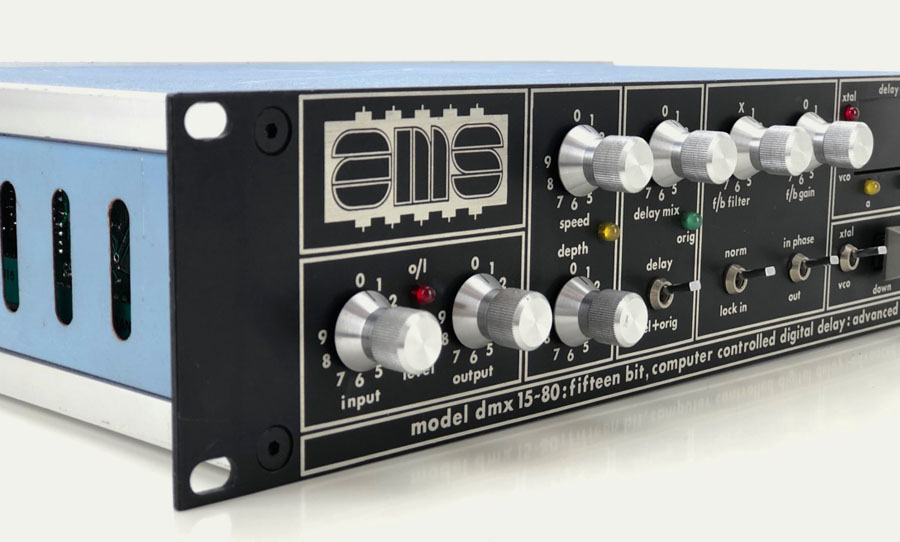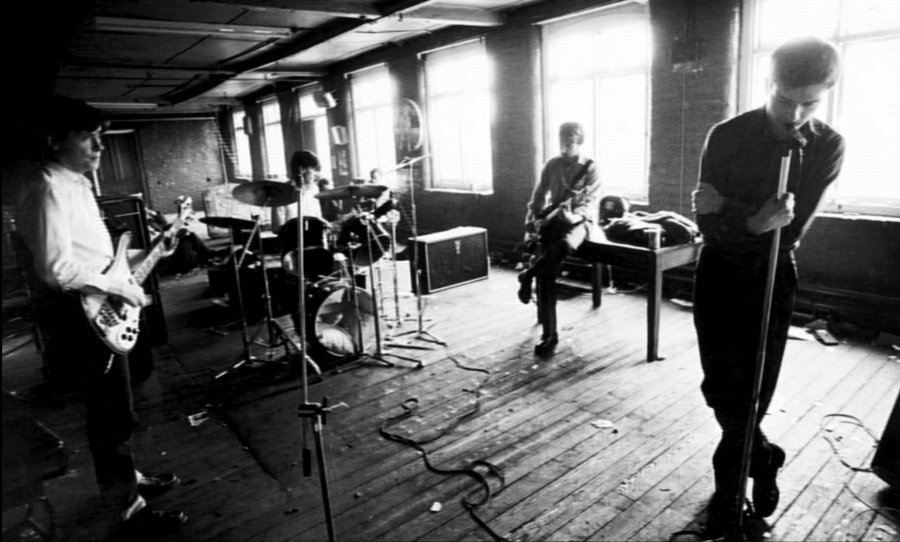The AMS DMX 15-80 was the world’s first microprocessor-controlled digital delay. It emerged in the late ’70s, preceded by analog tape delays and succeeded ultimately by pedals, and eventually, plugins.
Yet the AMS digital delay had a profound impact on the audio world, opening producers up to a newfound world of expression. Nowhere is this more evident than in the story of the sonically groundbreaking record Unknown Pleasures, the band Joy Division, and the legendary producer Martin Hannett.
The AMS digital delay was the first of its kind, heralding a whole new era of digital effects in music, and forever deepening the possibilities of production.
Before the invention of delay, music was recorded in resonant spaces to achieve the effect of reverberation. Inconvenient for both musician and engineer, the first types of delay units emerged in the 1940s as an alternative. These early delay effects made use of loops on the reel-to-reel tape systems of the time. They were, however, elaborate and difficult to use. By the end of the decade, sound engineers began adapting them for use in recording studios and live purposes.
In the ’50s, the first commercial tape echoes became available. The earliest of these was EchoSonic, a guitar amplifier with an in-built tape echo effect made by the American engineer Ray Butts in 1952. Next came the Echoplex, a tape echo effect created by Mike Battle in 1959, followed by Roland’s Space Echo in 1973, an audio effects unit capable of both reverb and delay. These analog effects were easy to use and capable of creating real-time echo effects. The only downside was that the magnetic tape would often degrade, impacting the audio fidelity.
With the ’70s came the emergence of digital audio recording technology, and with the increasing prevalence of inexpensive digital signal processing electronics, the digital delay was finally born. Passing the signal through an analog-to-digital converter, these delays operated by recording audio and allowing it to be manipulated by user-set parameters, before passing back through a digital-to-analog converter. In 1978, a company named AMS, founded by two aerospace engineers, invented the DMX 15-80.
That same year, Joy Division were recording at Strawberry Studios in Stockport, Manchester, with a producer named Martin Hannett. Two weeks prior, Hannett had received the new AMS delay. “It was called ‘Digital,'” described Hannett. “It was heaven-sent.”

Hannett was one of the earliest users of the AMS digital delay. With his help, Joy Division would go onto record their critically acclaimed debut record, Unknown Pleasures, the following year. It was released through the Manchester-based independent record label, Factory Records, in 1979. At a moment of such seminal changes in technology, the recording couldn’t have been better timed.
Hannett was infamous for his quirks – and whilst these made for an entertaining mythology which came to surround him, it was ultimately this out-of-the-box thinking which led to his groundbreaking production techniques, including the use of the AMS digital delay.
Joy Division guitarist Bernard Sumner describes how during the recording of She’s Lost Control, Hannett had the idea of getting drummer Stephen Morris to play the hi-hat pattern using fly spray in the vocal booth. “It nearly killed Steve,” Sumner recalls.
According to legend, Hannett also forced Morris to set up his drums on the roof of the studio to record the song. Allegedly, Hannett would also make Morris record every drum part – snare, bass drum, toms, and cymbals – separately, in order to eradicate any bleed. Once Hannett reportedly heard a rattle in the drum kit and made Morris disassemble the whole thing, only to reassemble it again. These stories are depicted in the 2002 movie about Factory Records, 24 Hour Party People.
Hannett had a scientific background. Born in Manchester, he received a degree in chemistry at the University of Manchester Insitute of Science and Technology, however, he chose to pursue a career in music. Hannett possessed extensive knowledge of music technology and was an expert in synthesis. He was also a performing musician with a diverse appreciation for music, including avant-garde electronic music and dub. His approach to production was the perfect storm of the scientific and the creative.
Hannett believed that effects like delay, chorus, and reverb were “gifts to the imagination.” Allegedly, he considered punk rock sonically conservative due to its failure to embrace the changing technology of the time. To Hannett, Joy Division seemed to exist in a perfect place between the two worlds.
“There was a lot of space in [Joy Division’s] sound,” remembers Hannett. “They were a gift to a producer, because they didn’t have a clue. They didn’t argue.”
Whilst recording Unknown Pleasures, Hannett ensured that he captured performances from the band that would allow for flexibility during the mixing process (like recording Morris’ drums individually). Hannett liked to undertake the mixing process by himself. Effects like delay became a way for him to compensate for the sparseness of the raw material. He saw them as adding “little attention-grabbing things, into the ambient environment, just in case interest was flagging in the music.”

“The studio was Martin’s,” remembers Morris. “And when you were in the studio you were working for Martin and his whims. There was an awful lot of pot smoked: whether Martin was completely stoned or did have a different outlook on what he wanted, he would be obtuse. He wouldn’t say to you, ‘I want you to do it like this.’ It was, ‘Great, do it again but more cocktail party’ or ‘a bit more yellow.’ Whether it was pot or whether it was the Zen school of production, it was definitely interesting, because he turned us on to the studio being a musical instrument.”
The dynamic between Hannett and Joy Division brings to light intricate questions about the role of the producer in the studio. Grammy-award winning American producer Bill Bottrell describes a shift that occurred in the late ’70s, around the time of Unknown Pleasures, where engineers and producers began to impose themselves on recordings. It’s a scenario he believes should never have occurred. And yet, without Hannett’s profound influence, Unknown Pleasures may not be the same album that it is today.
Even so, Hannett’s approach did not produce the outcome the band desired. Rather than the rocky, aggressive record they’d envisioned, Unknown Pleasures was subtle, dark, and cavernous.
Bassist Peter Hook recalls wanting the music to have an abrasive effect, like that of Iggy Pop. “I wasn’t interested in depth or anything, I just wanted to kick them in the teeth, and that was it. But that’s not the way that things survive. Martin had obviously been through that and realised there was a lot to be said for subtlety, and also a lot of depth and melancholy and sucking people in. Instead of screaming in their faces, you were whispering in their ear, weren’t you? Martin Hannett whispering in people’s ears, and me and Bernard wanted to scream in people’s faces.”

Using the AMS DMX 15-80, Hannett created a sense of space in the recording, ricocheting snare hits back and forth, or warping the overall drum sound with an incredibly quick delay time so that they almost didn’t sound like drums at all. Hannett’s use of panning also contributed to this sense of space, placing an instrument on one side of the mix, whilst positioning its delayed release on the other side.
Morris likens the process of working with Hannett to being on a science-fiction journey – one you weren’t quite sure how it was going to end. “I thought Unknown Pleasures was a very futuristic sounding record and I was very proud of it,” he reflects.
Ultimately, whilst the album didn’t end up as they’d envisioned, it went on to have a profound impact.
“We played the album live and heavy. We felt that Martin toned it down, especially the guitars,” Sumner described to Savage. “The production inflicted his dark, doomy mood over the album; we’d drawn this picture in black and white, and Martin coloured it in for us. We resented it, but Rob [Gretton] loved it, Tony [Wilson] loved it, the press loved it, and the public loved it. We were just the poor stupid musicians who wrote it.”
“One of the strengths of Joy Division’s music is that we were in the learning process,” describes Sumner. “And what you can actually hear is someone exploring music and how to play it and: ‘Don’t really know what I do with it, but that sounds good.'”
Ultimately, the AMS digital delay was superseded. In the ’80s, as digital memory became cheaper, smaller delay units were created in the form of pedals. Eventually, the 2000s saw the invention of audio software plugins that we use freely today. However, the AMS DMX 15-80, and the influence of albums like Unknown Pleasures, remains to this day.


